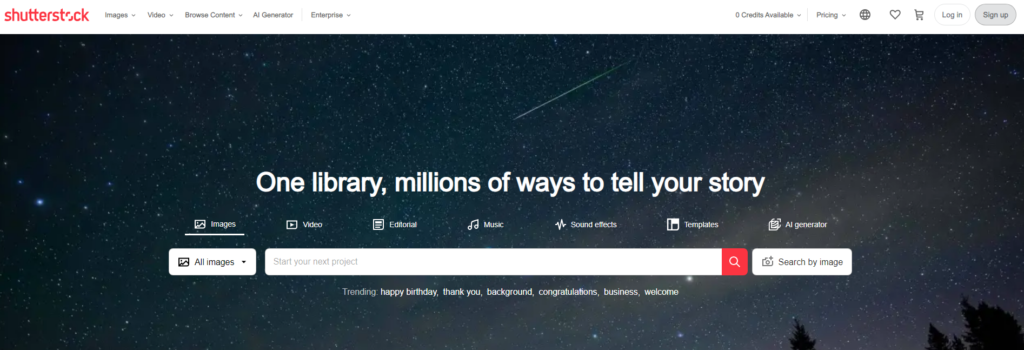
In a world where visual content reigns supreme, the demand for high-quality video footage has never been greater. From dynamic marketing campaigns to engaging social media posts, businesses and creators are in constant search of captivating visuals to tell their stories.
This surge in demand opens up a golden opportunity for videographers and content creators to turn their passion into profit by selling stock footage.
Imagine capturing the beauty of a sunrise, the hustle and bustle of a city street, or the serene calm of a forest, and then earning money from those moments over and over again. Selling stock footage allows you to create a steady stream of passive income, all while doing what you love.
But how do you get started? What platforms should you use? How can you ensure your footage stands out in a crowded market?
In this comprehensive guide, we’ll take you on a journey through the world of stock footage. We’ll explore the best platforms for selling your clips, share tips on optimizing your footage for maximum earnings, and provide insights into what buyers are looking for.
Whether you’re a seasoned professional or just starting out, this guide will equip you with the knowledge and strategies you need to succeed in the lucrative world of stock footage. Get ready to unlock the potential of your camera and turn your creativity into cash!
Think about the impact of a single video, like this one, “How To Instantly Upgrade Your Life” . It’s a quick and inspiring message that can resonate with viewers and potentially change their perspective. Stock footage can be the visual foundation for these kinds of powerful messages, and you can be the one creating them.
For More Free Videos, Subscribe to the Rhodes Brothers YouTube Channel.
TL;DR
- Unlock the power of passive income: Learn how to sell stock footage and earn money while you sleep.
- Master the art of capturing compelling footage: Discover the secrets to shooting high-quality videos that sell.
- Navigate the world of stock footage platforms: Explore the best platforms to showcase your work and reach a global audience.
- Optimize your footage for maximum earnings: Learn the techniques to enhance your videos and attract buyers.
- Build a sustainable stock footage business: Discover strategies for consistent income and long-term success.
Choosing the Right Gear
The first step in your stock footage journey is choosing the right equipment. While you can start with what you have, investing in quality gear will significantly enhance the marketability of your footage.
Cameras
- DSLRs: Offer versatility and image quality, making them a popular choice for stock footage. Examples include the Canon EOS 80D, Nikon D7500, and Sony Alpha a6600.
- Mirrorless cameras: Compact and lightweight, with excellent image quality and advanced features. Examples include the Sony Alpha a7 III, Fujifilm X-T4, and Olympus OM-D E-M1 Mark III.
- Action cameras: Ideal for capturing dynamic and high-action footage. Examples include the GoPro Hero 10 Black, DJI Osmo Action 3, and Insta360 ONE RS.
- Smartphones: While not ideal for professional-grade footage, they can be a good starting point for beginners. Modern smartphones like the iPhone 14 Pro and Samsung Galaxy S23 Ultra have impressive cameras capable of capturing decent quality footage.
Lenses
- Wide-angle lenses: Capture a broader field of view, perfect for landscapes and cityscapes. Examples include the Canon EF 16-35mm f/2.8L III USM, Nikon AF-S NIKKOR 14-24mm f/2.8G ED, and Sony FE 16-35mm f/2.8 GM.
- Telephoto lenses: Zoom in on distant subjects, ideal for wildlife or sports footage. Examples include the Canon EF 100-400mm f/4.5-5.6L IS II USM, Nikon AF-S NIKKOR 70-200mm f/2.8E FL ED VR, and Sony FE 70-200mm f/2.8 GM OSS.
- Macro lenses: Capture intricate details, perfect for close-up shots of flowers or insects. Examples include the Canon EF 100mm f/2.8L Macro IS USM, Nikon AF-S DX Micro NIKKOR 85mm f/3.5G ED VR, and Sony FE 90mm f/2.8 Macro G OSS.
Audio
- External microphones: Capture high-quality sound, essential for capturing dialogue or ambient noise. Examples include the Rode NTG3, Sennheiser MKH 416, and Zoom H6.
- Lavalier microphones: Clip-on mics ideal for interviews or voice-overs. Examples include the Rode Lavalier II, Sennheiser ME 2-II, and Sony ECM-CS3.
- Shotgun microphones: Directional mics designed to pick up sound from a specific direction. Examples include the Rode NTG4+, Sennheiser MKE 600, and Zoom F8n.
Editing Software
- Adobe Premiere Pro: Industry-standard editing software with powerful features.
- Final Cut Pro: Apple’s professional video editing software.
- DaVinci Resolve: A free and powerful editing software with professional-grade features.
Capturing Compelling Footage
Now that you have the gear, it’s time to start capturing footage. But it’s not just about pressing the record. Here are some tips for shooting high-quality stock footage:
Understand the Market
- Research popular categories: Explore what types of footage are in high demand, such as nature, cityscapes, technology, or lifestyle. Use tools like Shutterstock’s “Trending Footage” section or Pond5’s “Popular Searches” to get a sense of what’s selling.
- Identify trends: Stay updated on current trends and popular video styles. Look at popular social media platforms like TikTok, Instagram Reels, and YouTube Shorts for inspiration.
- Analyze successful footage: Study footage that sells well to understand what makes it appealing. Look at the descriptions, keywords, and tags used by successful sellers.
Composition and Framing
- Rule of thirds: Divide your frame into thirds horizontally and vertically, placing key elements along the lines or intersections. This creates a more balanced and visually appealing composition.
- Leading lines: Use natural lines in the scene to guide the viewer’s eye. For example, a road leading to a distant mountain or a fence leading to a building.
- Depth of field: Use aperture settings to create a shallow depth of field, blurring the background and highlighting your subject. This can be achieved by using a wide aperture (low f-stop number) on your lens.
Lighting and Exposure
- Natural light: Use natural light whenever possible, as it creates a more pleasing aesthetic. The “golden hour” (the hour after sunrise and the hour before sunset) is particularly popular for its warm and soft light.
- Artificial light: When shooting indoors or in low-light conditions, use artificial light sources. Consider using lamps, flashlights, or even your phone’s flashlight to create a more controlled lighting environment.
- White balance: Ensure accurate color representation by adjusting the white balance. This can be done manually or automatically using your camera’s settings.
- Exposure: Find the right balance between light and dark areas in your footage. This can be adjusted using the shutter speed, aperture, and ISO settings on your camera.
Motion and Movement
- Smooth transitions: Use smooth camera movements to create a professional look. Practice panning, tilting, and tracking shots to create a sense of motion.
- Dynamic shots: Capture movement and action to make your footage more engaging. This could involve shooting a car driving down a road, a bird flying in the sky, or a person walking through a park.
- Variety of angles: Shoot from different angles to provide a dynamic perspective. Try shooting from low angles, high angles, and even from behind objects to create a more interesting visual experience.
Sound Design
- Clean audio: Ensure your audio is clear and free of noise. Use a good quality microphone and record in a quiet environment to minimize unwanted noise.
- Ambient sound: Capture the natural sounds of the environment for a more immersive experience. This could include the sound of birds chirping, waves crashing, or city traffic.
- Music and sound effects: Use appropriate music and sound effects to enhance your footage. There are many free and paid resources available online for royalty-free music and sound effects.
Marketing Your Stock Footage
With your footage captured and edited, it’s time to market it to potential buyers.
Choosing the Right Platform
- Shutterstock: One of the largest stock footage platforms, offering a wide range of footage categories.

- Pond5: Another popular platform with a large community of buyers and sellers.
- Adobe Stock: Integrated with Adobe Creative Cloud, making it accessible to a wide audience.
- VideoHive: A platform specializing in motion graphics and video templates.
- iStockphoto: A platform with a focus on high-quality images and footage.
Optimizing Your Footage
- Keywords: Use relevant keywords to make your footage searchable. Research popular keywords on the platform you choose and use a variety of terms, including specific and general keywords.
- Descriptions: Provide detailed descriptions that accurately reflect your footage. Include information about the location, time of day, subject matter, and any other relevant details.
- Tags: Add tags to categorize your footage and make it easier to find. Use a combination of general and specific tags to ensure your footage is easily discoverable.
- Thumbnails: Create eye-catching thumbnails that grab attention. Use high-quality images that represent your footage and include text that highlights the key features.
Building a Portfolio
- Showcase your best work: Create a portfolio that highlights your most compelling footage. Include a variety of footage categories and showcase your skills in different areas.
- Diversify your content: Offer a variety of footage categories to appeal to a wider audience. This could include nature, cityscapes, technology, lifestyle, and more.
- Update your portfolio regularly: Add new footage to keep your portfolio fresh and relevant. Consistently upload new content to attract buyers and keep your portfolio updated with the latest trends.
Promoting Your Work
- Social media: Share your footage on social media platforms like Instagram, Twitter, and Facebook. Use relevant hashtags and engage with your followers to promote your work.
- Website: Create a website to showcase your work and provide contact information. A website can be a great way to build your brand and showcase your best work.
- Networking: Connect with other filmmakers and stock footage creators. Attend industry events, join online communities, and build relationships with other professionals.
Maximizing Your Earnings
Once you’ve established a presence on stock footage platforms, you can start maximizing your earnings.
Pricing Strategies
- Competitive pricing: Research the pricing of similar footage to determine a competitive rate. Look at the pricing of other sellers on the platform and adjust your prices accordingly.
- Value-based pricing: Price your footage based on its quality, uniqueness, and potential use. If your footage is high-quality, unique, and has a wide range of potential uses, you can charge a premium price.
- Exclusive licensing: Offer exclusive licensing rights to your footage for higher prices. This means that the buyer has the exclusive right to use the footage for a specific period of time or for a specific project.
Tips for Success
- Consistency: Upload new footage regularly to keep your portfolio fresh and attract buyers. Aim to upload new footage on a weekly or monthly basis to keep your portfolio updated.
- Quality over quantity: Focus on creating high-quality footage rather than simply uploading a large volume. It’s better to have a smaller portfolio of high-quality footage than a large portfolio of mediocre footage.
- Feedback and reviews: Pay attention to feedback and reviews to improve your work. Respond to feedback and use it to improve your future footage.
- Stay updated: Keep up with the latest trends and technologies in the stock footage industry. Stay informed about new platforms, trends, and technologies to stay ahead of the curve.
Actionable Steps for Selling Stock Footage: A Guide for Everyone
Selling stock footage can be a lucrative side hustle or even a full-time career, but it requires a strategic approach. Here’s a breakdown of actionable steps for different experience levels:
For Beginners:
- Start with what you have: Don’t feel pressured to invest in expensive gear right away. Your smartphone camera can be a great starting point.
- Learn the basics: Familiarize yourself with video composition, lighting, and sound. There are tons of free resources online, including YouTube tutorials and articles.
- Choose a platform: Start with a platform like Shutterstock or Pond5, which are beginner-friendly and have a large buyer base.
- Capture simple footage: Focus on capturing everyday scenes like cityscapes, nature shots, or people interacting.
- Optimize your footage: Use relevant keywords, write detailed descriptions, and add tags to make your footage easily discoverable.
- Build a small portfolio: Start with a few high-quality videos and gradually expand your collection.
For Intermediate Users:
- Invest in quality gear: Consider upgrading to a DSLR or mirrorless camera and a decent microphone.
- Explore different categories: Branch out beyond everyday scenes and capture more specialized footage like travel, food, or technology.
- Experiment with editing: Learn basic editing techniques to enhance your footage and create more engaging videos.
- Promote your work: Share your footage on social media, create a website, and network with other filmmakers.
- Analyze your performance: Track your earnings, feedback, and download numbers to understand what’s working and what needs improvement.
For Experienced Filmmakers:
- Specialize in a niche: Focus on a specific genre or category where you have expertise and passion.
- Create high-end footage: Invest in professional-grade gear and techniques to produce top-notch quality videos.
- Offer exclusive licensing: Consider offering exclusive rights to your footage for higher prices.
- Build a strong brand: Develop a unique style and voice to differentiate yourself from the competition.
- Network strategically: Connect with potential clients, producers, and other industry professionals.
Additional Tips for Everyone:
- Stay updated: Keep learning about new trends, platforms, and technologies in the stock footage industry.
- Seek feedback: Ask for feedback from other filmmakers or potential buyers to improve your work.
- Be patient: Building a successful stock footage business takes time and effort. Don’t get discouraged if you don’t see results immediately.
- Have fun: Enjoy the creative process and the satisfaction of seeing your work used in various projects.
Remember, the key to success in selling stock footage is to consistently create high-quality content, market your work effectively, and adapt to the ever-changing demands of the industry.
Common Mistakes to Avoid
- Ignoring market research: Not understanding the demand for specific footage can lead to wasted time and effort. Research the market before you start shooting to ensure there is a demand for your footage.
- Using low-quality equipment: Shooting with poor equipment will result in footage that is unlikely to sell. Invest in quality equipment to ensure your footage meets the standards of stock footage platforms.
- Neglecting sound design: Poor audio quality can significantly detract from the value of your footage. Use a good quality microphone and pay attention to sound design to create professional-sounding footage.
- Overlooking marketing: Failing to promote your work effectively can limit your reach and earnings. Promote your work on social media, create a website, and network with other filmmakers.
- Not diversifying your content: Relying on a single category of footage can limit your potential buyers. Offer a variety of footage categories to appeal to a wider audience.
Frequently Asked Questions
How do I get started with selling stock footage?
Begin by choosing the right equipment, learning the basics of video production, and selecting a stock footage platform. Start with a few high-quality videos and gradually expand your portfolio.
What are the best platforms for selling stock footage?
Popular platforms include Shutterstock, Pond5, Adobe Stock, VideoHive, and iStockphoto. Each platform has its own strengths and weaknesses, so research them carefully to find the best fit for your needs.
How do I price my stock footage?
Research the pricing of similar footage on different platforms to determine a competitive rate. Consider the quality, uniqueness, and potential use of your footage when setting your prices.
How can I make my footage more marketable?
Use relevant keywords, provide detailed descriptions, add tags, and create eye-catching thumbnails. Optimize your footage for search engines and make it easy for buyers to find.
What are the legal considerations for selling stock footage?
Ensure you have the necessary rights and permissions to use any copyrighted material in your footage. Check the terms and conditions of the stock footage platforms you use to understand their licensing agreements.
How can I improve the quality of my footage?
Invest in quality equipment, learn the basics of composition, lighting, and sound design. Practice your skills and seek feedback from other filmmakers.
What are some tips for capturing compelling footage?
Understand the market, research popular categories, and identify trends. Use the rule of thirds, leading lines, and depth of field to create visually appealing compositions.
How do I promote my stock footage?
Use social media, create a website, and network with other filmmakers. Share your work on relevant platforms and engage with potential buyers.
What are the common mistakes to avoid when selling stock footage?
Ignoring market research, using low-quality equipment, neglecting sound design, overlooking marketing, and not diversifying your content.
How can I make a sustainable income from selling stock footage?
Focus on creating high-quality footage, consistently upload new content, and optimize your work for search engines. Build a strong portfolio and promote your work effectively.
The Power of Passive Income
As Warren Buffet famously said, “If you don’t find a way to make money while you sleep, you will work until you die.” Selling stock footage can be a powerful tool for building a stream of passive income. It allows you to leverage your creativity and technical skills to earn money while you pursue other passions or simply enjoy your free time.
Get started today by taking the first step: Choose a stock footage platform, capture some high-quality footage, and start building your portfolio.
Thank you for joining us! Be sure to check out Rhodes Brothers YouTube Channel for the latest videos and information to help you succeed.
Resource List:
Tools:
- Adobe Premiere Pro
- Final Cut Pro
- DaVinci Resolve
- Shutterstock
- Pond5
- Adobe Stock
- VideoHive
- iStockphoto
Selling Stock Footage Cheat Sheet:
- Choose the right gear: Camera, lens, microphone, editing software
- Capture compelling footage: Understand the market, composition, lighting, motion, sound
- Market your footage: Choose a platform, optimize your work, build a portfolio, promote your work
- Maximize your earnings: Pricing strategies, consistency, quality, feedback, stay updated
- Avoid common mistakes: Market research, low-quality equipment, poor audio, neglecting marketing, lack of diversity
- Resources: Books, blogs, podcasts, tools
- Get started today: Choose a platform, capture footage, build your portfolio
- Passive income: Earn money while you sleep
- Creativity and technical skills: Leverage your strengths to build a successful business
- YouTube channel: Subscribe for the latest videos and information






